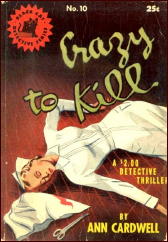Fri 4 Feb 2011
Reviewed by William F. Deeck: ANN CARDWELL – Crazy to Kill.
Posted by Steve under Authors , Bibliographies, Lists & Checklists , Crime Fiction IV , Reviews[6] Comments
William F. Deeck
ANN CARDWELL – Crazy to Kill. Mystery House, hardcover, 1941. Black Cat Detective #10, digest paperback, 1944. Harlequin #22, Canada, pb, 1949. Macfadden 35-119, paperback, 1962. Nightwood Editions, softcover, Canada, 1990. The book was also converted to an opera with this title by James Reaney, Sr., and John Beckwith; it was performed in Canada in 1989.

After spending ten years in Resthome, a private hospital for “nervous” cases, Agatha Lawson, a spinster in her early sixties, is due to be released. Unfortunately, just at this time a grisly series of attacks and murders involving the staff starts taking place at the hospital.
Since Lawson is around at the time of each episode, she feels that she is more than capable to solve the case, particularly in view of the incompetence of Lieutenant Hogan of the local police.
Also aware that Hogan is beyond his depth, the authorities bring in another detective, this one willing to consult with Lawson. Between them, the murderer is apprehended.
One of the rare mysteries with a mental institution setting and one of the rare… But that mustn’t be revealed.
Forget that this novel was published by Mystery House, a publisher of third- and fourth-rate novels. While not in the first rank, this is nonetheless quite readable.
Bibliography: Adapted from the Revised Crime Fiction IV, by Allen J. Hubin —
ANN CARDWELL. Pseudonym of Jean Makins Powley, 1902-1966. Daughter of a judge in Stratford, Ontario.
Crazy to Kill. Mystery House, 1941.

Murder at Calamity House. Arcadia House, 1947.
February 4th, 2011 at 10:32 pm
I don’t know about you, but I think Bill left a lot of things unsaid in this review, which I found totally intriguing.
First of all, what sway does Agatha Lawson, committed to a mental institution for ten years, have over the police that another investigator is called in? One who even consults with her, quite unlike the usual run-of-the-mill detective thriller.
And of course Bill is acting more coy than usual when he teases us with there’s something rare about the case that he’s unwilling to tell us about.
But I’m sure the fact that an opera was based on the book, about as obscure in this country as one you could hope to find, must be nearly one-of-a-kind, especially when you consider the setting. The author, perhaps, under her real name, was more known in Canada, than I’m presently aware of.
As for Mystery House being a third- or fourth-rate publisher, Bill was right about that. For a list of other titles they published in the 1940s, check out http://www.lendinglibmystery.com/MHouse/Covers.html
Curious about Bill’s final statement that the book is “quite readable,” I found this other review, which I’d like to share with you, in part. It’s by Isaac Anderson, and it appeared in the NEW YORK TIMES:
“What is a detective to do when most of his witnesses are insane and when even the doctors and nurses are afraid to tell all they know? It is a mad story, but if you can forgive the nonconformity to rules you will find it fascinating.”
February 4th, 2011 at 10:55 pm
This would seem to be an unknown gem from all the intriguing things suggested and unsaid.
There must be something unusual for it to be converted to an opera, and while the madhouse setting is unusual it was by no means all that rare. Francis Beeding’s THE HOUSE OF DOCTOR EDWARDES, the first of Patrick Quentin’s Peter and Iris Duluth novels, and Jonathan Latimer’s first Bill Crane novel all share the setting (Peter Duluth and Bill Crane are both in for the cure for drinking — though Crane is undercover).
This one deserves some digging it would seem. Hopefully a copy will show up and someone a bit more forthcoming can let us know what is so special about it.
February 4th, 2011 at 11:46 pm
David
Thinking along the same line as you, I went hunting for the book, not expecting anything to pop up for less than $20 or so, including the Black Cat reprint, quite collectible in its own right, but I was immediately (and pleasantly) surprised.
CRAZY TO KILL had a couple of printings from Macfadden in the 1960s, plus an earlier one from Harlequin I didn’t know about either.
I’ve added the info to the opening data, and ordered a copy of the book in VG condition for just over $5, including postage. I left quite a few others if you, or anyone else is interested.
— Steve
February 5th, 2011 at 11:57 am
That tantalizing sentence that ends “and one the rare…but that mustn’t be revealed” has got my imagination wheels spinning like mad.
I read the blurb on the Harlequin edition on a bookselling site/. Based on that and Bill’s review Crazy to Kill sounds like it might possibly have inspired that well known Alfred Hitchcock Hour episode “The Unlocked Window.” But according to imdb.com the source was an Ethel Lina White story.
Hmmm. I’m ordering one of the many books still available. Need to know the answer to this mystery.
February 5th, 2011 at 8:37 pm
Yes, the Alfred Hitchcock episode referred to is definitely based on the Ethel Lina White story (a brilliant one) of the same title.
The opera bit is wild.
February 18th, 2011 at 5:32 pm
[…] this month there was a post of a review of this book by Canadian author Ann Cardwell. The review by Bill Deeck ended with a tantalizing sentence […]